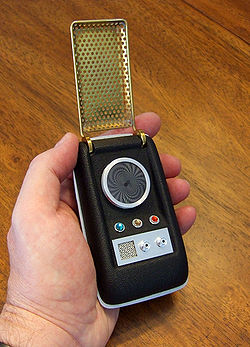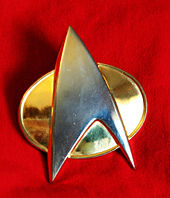- Communicator (Star Trek)
-
Communicator 
A 23rd-century communicator as used in Star Trek: The Original SeriesPlot element from the Star Trek franchise First appearance Star Trek
"The Cage" (1964)Created by Gene Roddenberry Genre Science fiction In-story information Type Communication device Function Allows subspace communication Communicators are devices used for voice communication in the fictional universe of Star Trek. They allow direct contact between individuals or via a ship's communication system.
The communicator in the Star Trek universe surpasses the capabilities of modern mobile phone technology. It allows crew members to contact starships in orbit without relying on an artificial satellite to relay the signal. Communicators use subspace transmissions that do not conform to normal rules of physics in that signals can bypass EM interference, and the devices allow nearly instantaneous communication at distances that would otherwise require more time to traverse.
In Star Trek: The Original Series (TOS), communicators functioned as a plot device, stranding characters in challenging situations when they malfunctioned, were lost or stolen, or went out of range (otherwise, the transporter would have allowed characters to return to the ship at the first sign of trouble, ending the storyline prematurely.[1]).
Contents
Development of communicators
Throughout Star Trek: Enterprise and TOS, on-ship communication is achieved via communicator panels on desks and walls, and sometimes through the use of videophones. While on away missions, the crew carried hand-held communicators that flip open. The top section contains a transceiver antenna and the bottom contains user controls, a speaker and a microphone. The device was designed and built by Wah Chang, who also built many of the other props used in the series.
Wrist-worn communicators were used in Star Trek: The Motion Picture and remained in use by some Starfleet installations and vessels during the time of The Wrath of Khan. However, the traditional handheld communicator returned in later films. The reason for the switch was not explained. The non-canon source Mister Scott's Guide to the Enterprise offered the explanation that Starfleet discontinued use of the wrist-worn communicators when they were determined to be prone to failure after suffering minor impacts.
In Star Trek: The Next Generation (TNG) and later series, Starfleet officers and enlisted personnel wear small communicator badges on their left breast. These devices are in the shape of the Starfleet insignia and are activated with a light tap. They also incorporate the universal translator. The first version of the communicator badge was used throughout the TNG series and during the first two seasons of Star Trek: Deep Space Nine (DS9). The second was used in later seasons of DS9, Star Trek: Voyager, and the TNG films. Use of the badges dates back at least as far as the time of the Enterprise-C (Lt. Richard Castillo is shown wearing a communicator badge in the TNG episode "Yesterday's Enterprise"). According to Data in the episode "Time's Arrow, Part One" at a poker game in 1893, the badge is made out of a crystalline composite of silicon, beryllium, carbon 70 and gold. In Deep Space Nine, Bajoran officers and enlisted personnel also wear a small communicator badge that functions much the same as their Starfleet counterparts. However Bajorans wear their badges on their right breast. Cardassians are shown to wear their communicators on their left wrist.
While wall and desk panels are still present, officers and crew consider them a secondary system, relying primarily on the badges. Viewscreens are used for visual communications. In Starfleet vessels and installations, communication can also be accomplished by verbally directing the computer to initiate communications with another person.
Relation to current technology
Dr. Martin Cooper, inventor of the modern mobile phone, credits the TOS communicator as being his inspiration for the technology. Although the first "brick" mobile phones were much larger, modern flip phones strongly resemble the original series communicator.[2]
In 2002, Vocera introduced an 802.11 Wi-Fi networked communications badge system similar to the Star Trek badges. The system uses voice recognition to determine whom a user wishes to call, just as the fictional badges did.
On July 12, 2010, CBS released an iPhone application created by Talkndog Mobile called Star Trek Communicator. The application replicates the design and iconic chirp of the communicator.[3]
No real-world equivalent to subspace communication has been developed, proposed, or theorized. However, many other aspects of Starfleet communications technology are commonplace. For example, locator functionality is implemented via GPS, LoJack, RFID, and radio direction finder devices.
References
- ^ "The Making of Star Trek", Roddenbery, G., and Whitfield, S.E., Ballentine, 1968
- ^ Edit International
- ^ http://www.iphonesavior.com/2010/07/star-trek-communicator-app-returns-to-iphone.html
External links
- Communicator at Memory Alpha (a Star Trek wiki)
Star Trek technology Communicator · Deflector shields · Emergency Medical Hologram · Holodeck · Hypospray · Impulse drive · LCARS · Phaser · Photon torpedo · Replicator · Transporter · Tricorder · Universal translator · VISOR · Warp driveCategories:- Star Trek devices
Wikimedia Foundation. 2010.

